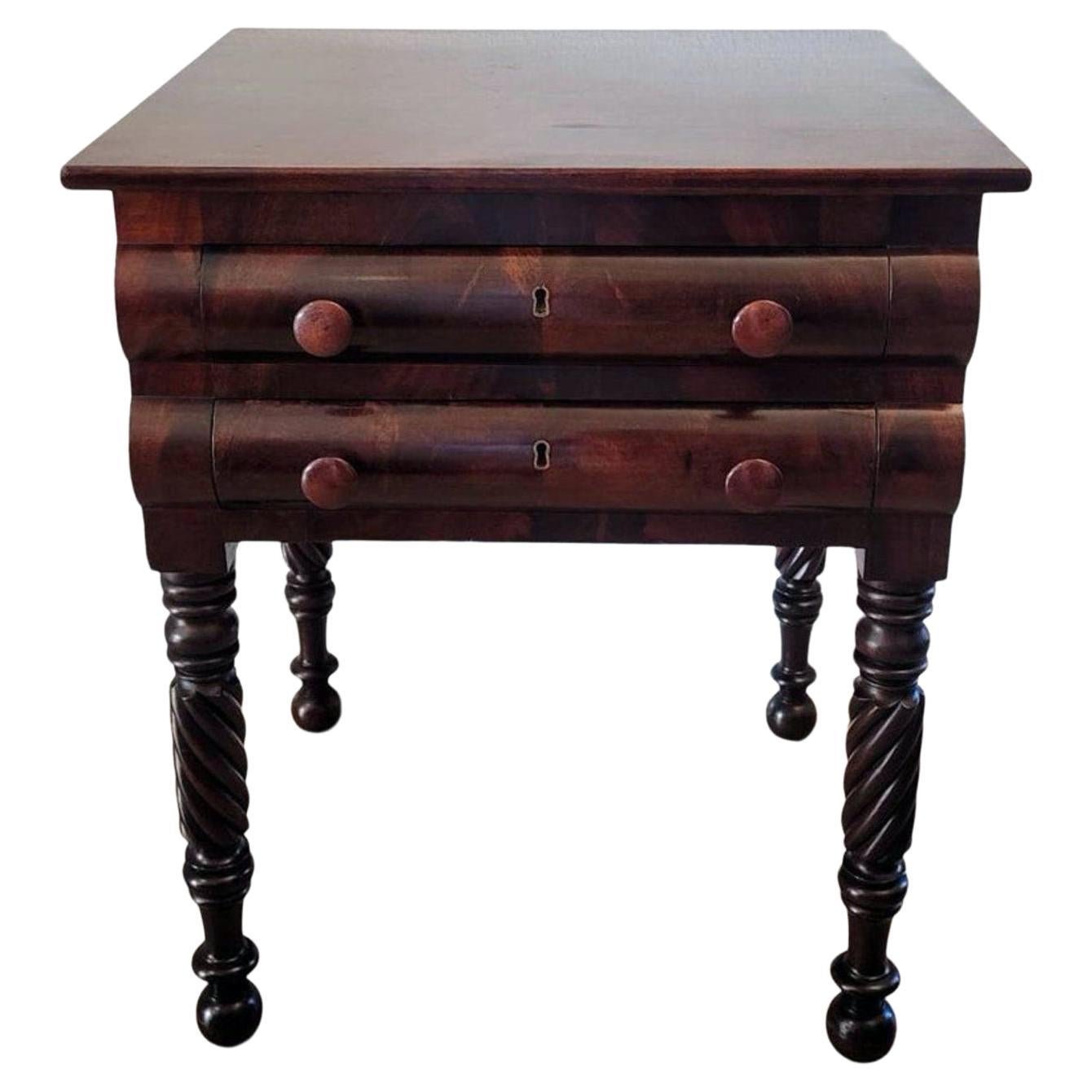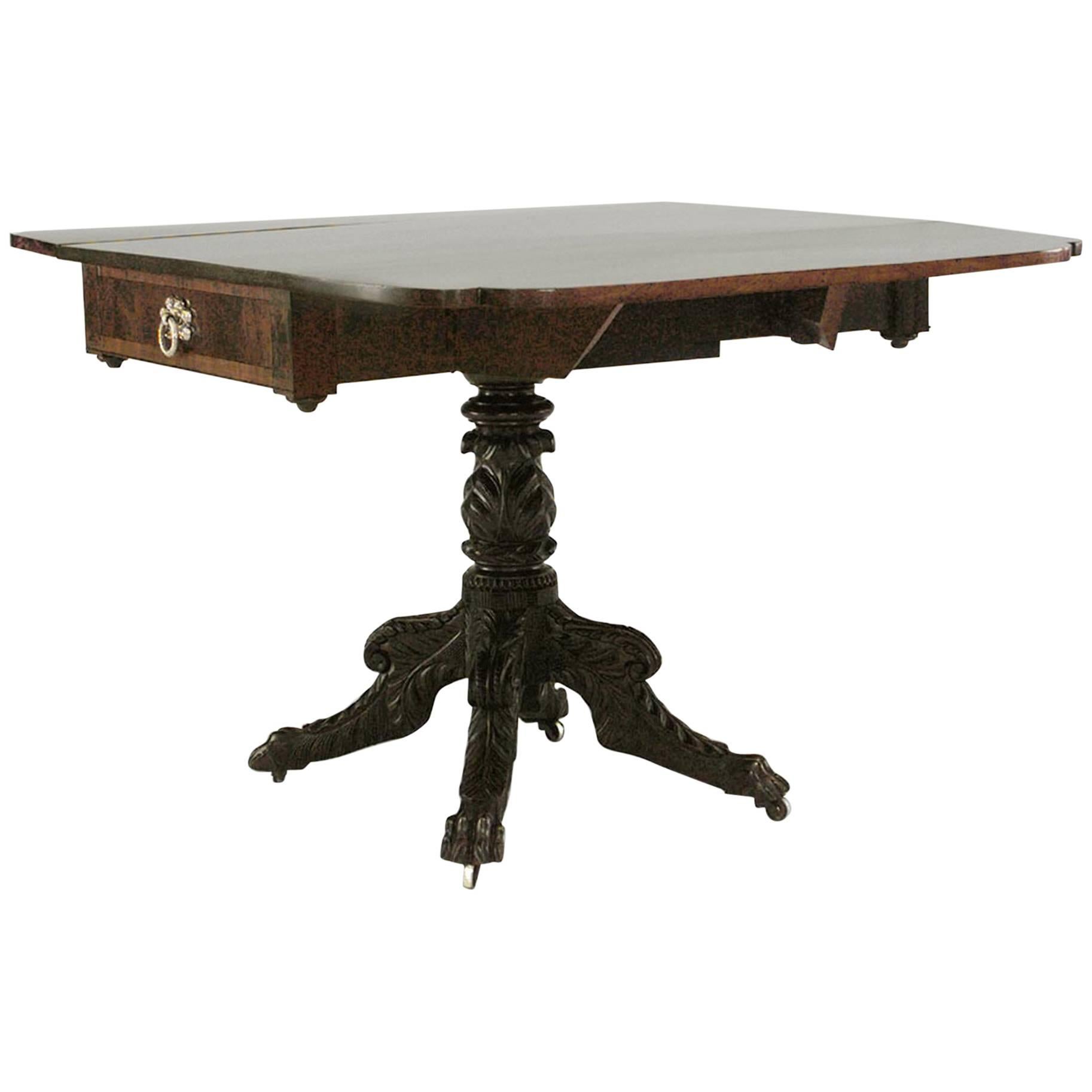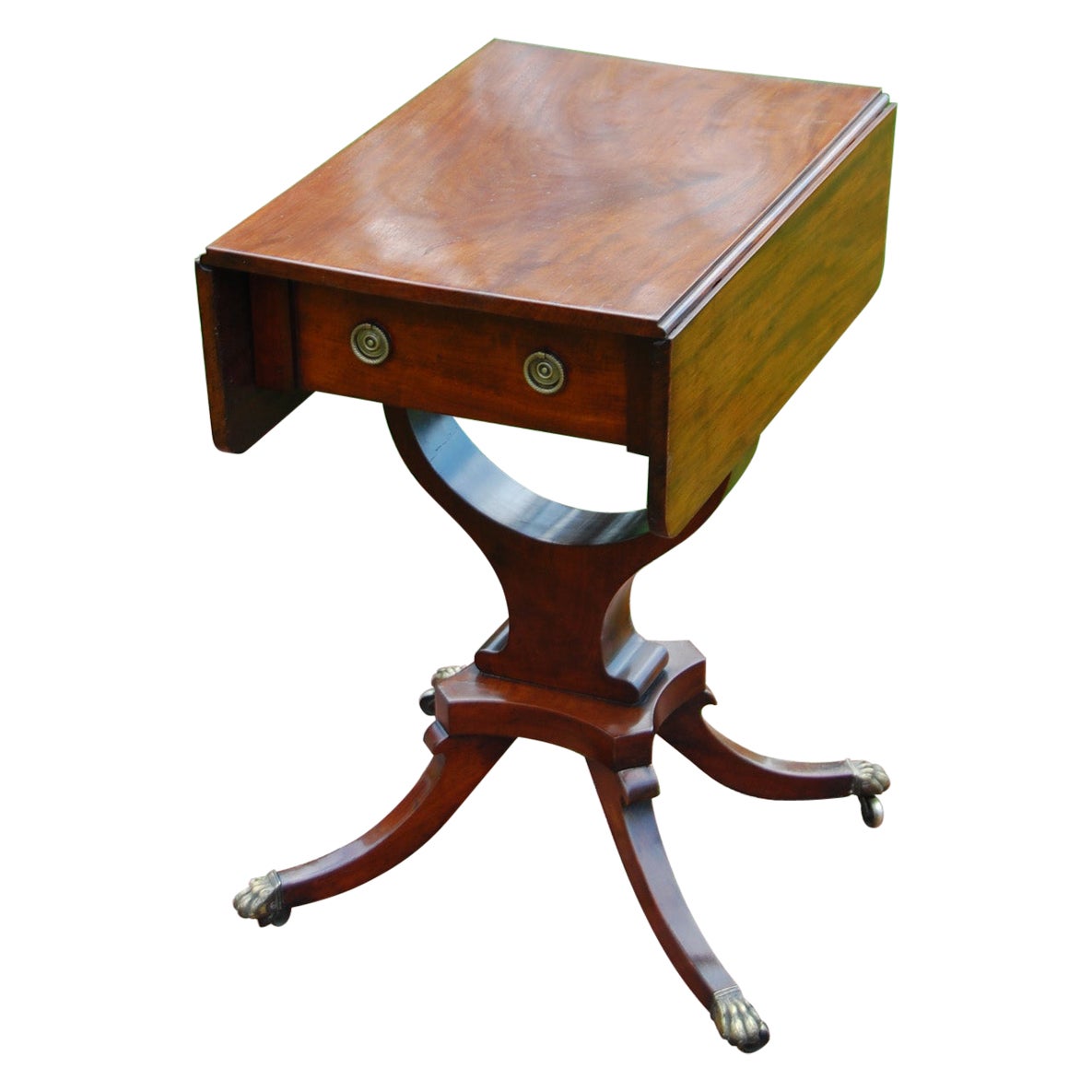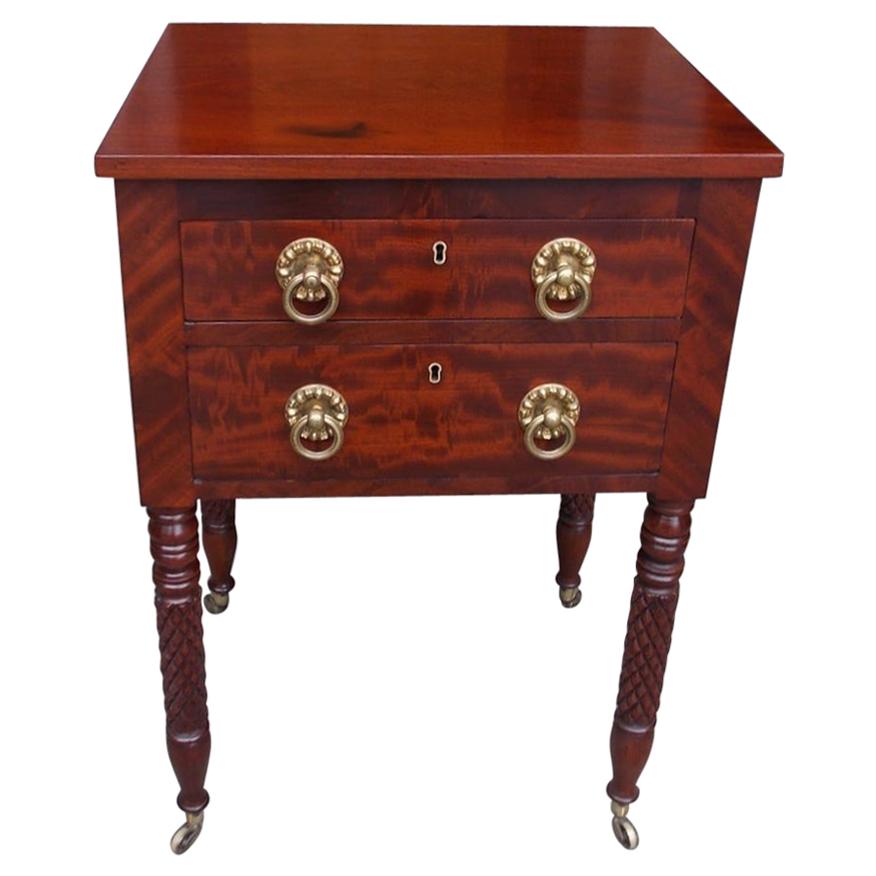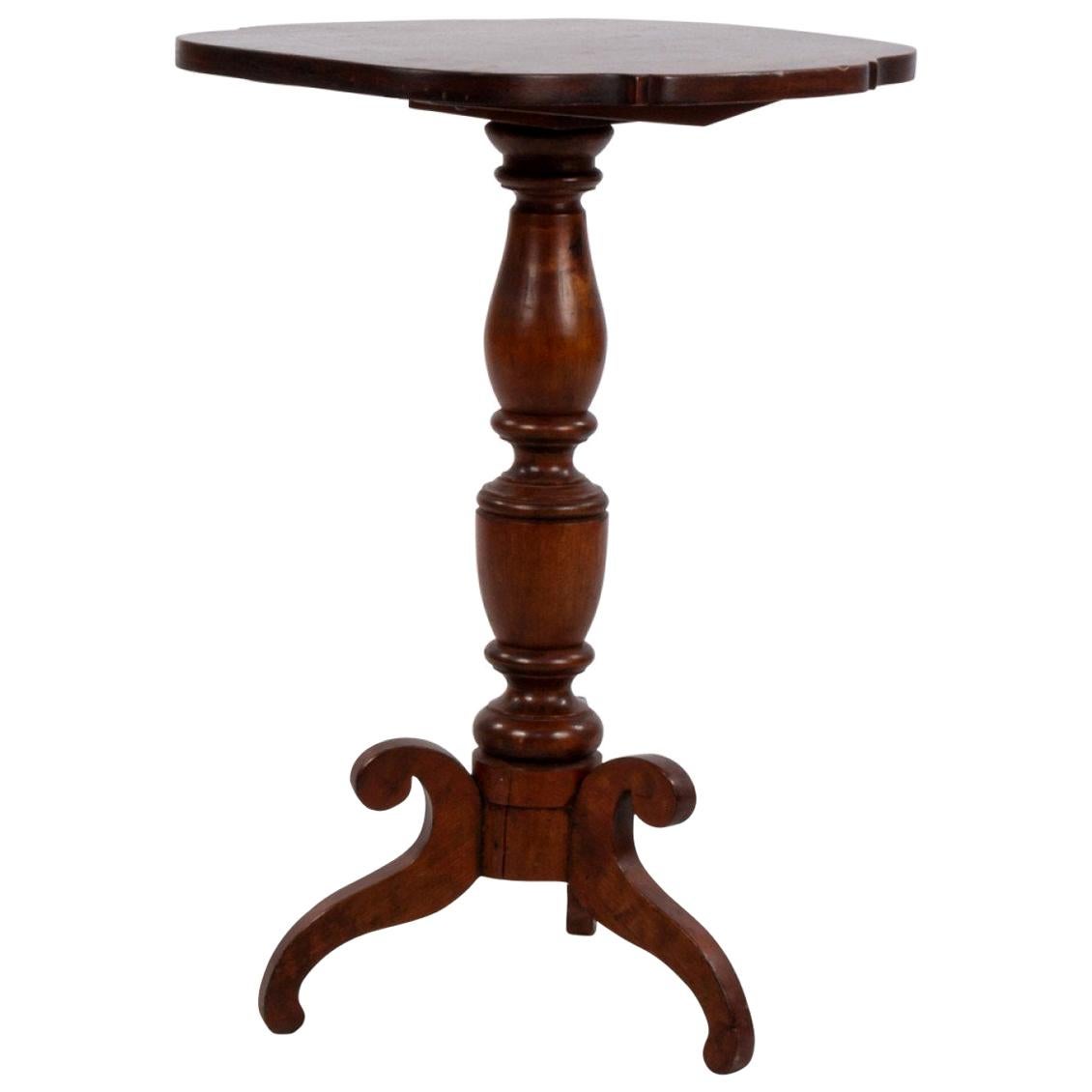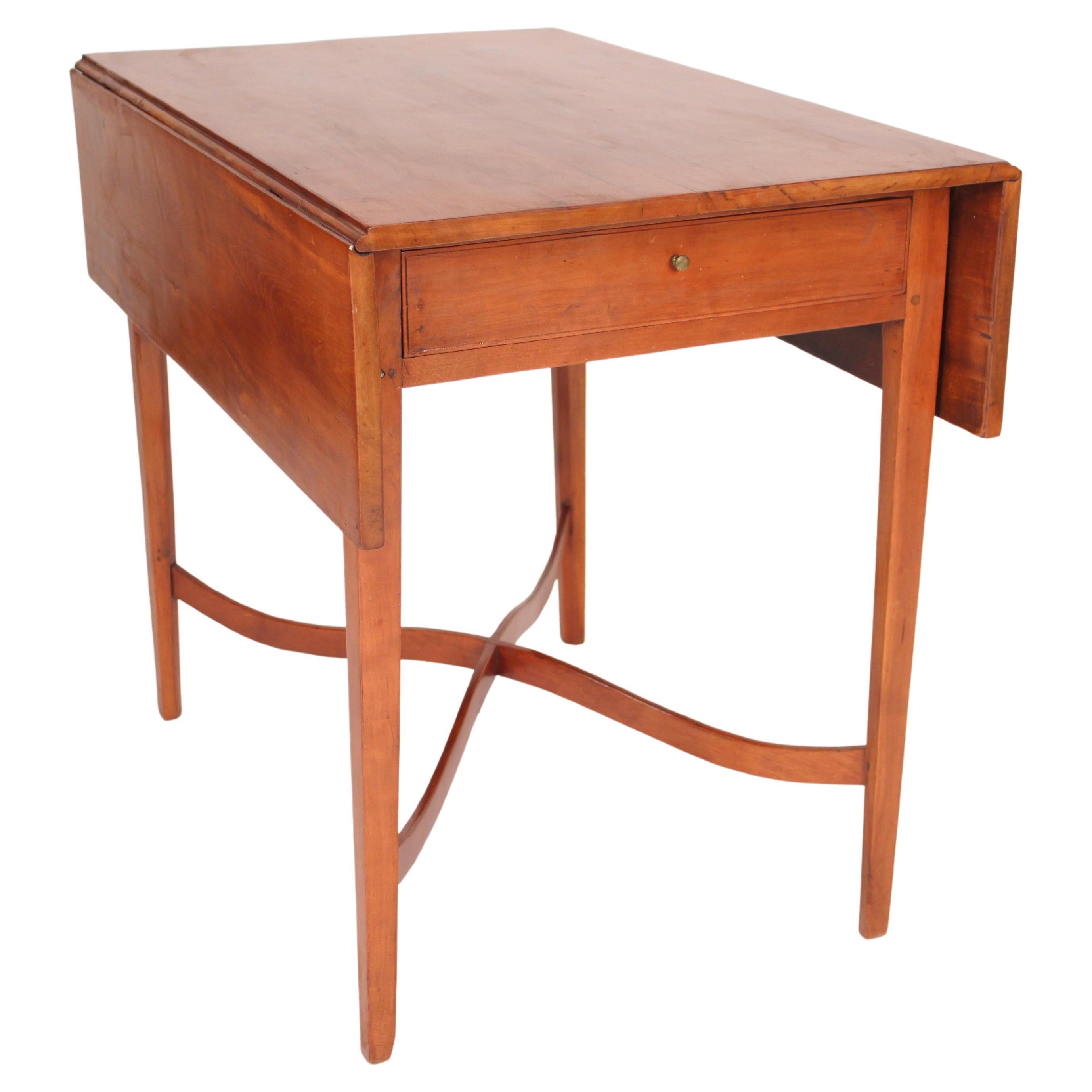Items Similar to Early American Federal Period Flame Mahogany Antique Wash Stand
Want more images or videos?
Request additional images or videos from the seller
1 of 21
Early American Federal Period Flame Mahogany Antique Wash Stand
About the Item
A rare and stunning Federal period (1789-1823) early American flame mahogany wash stand. circa 1810
Exquisitely hand-crafted in the Northeastern United States in the early 19th century, fine quality craftsmanship and construction with superb detail throughout, exceptionally executed in sophisticated Neoclassical form, having a dovetailed scrolled back splat over a bowed basin shelf on a conforming apron fitted with two small drawers, a later glass panel top displays a circular opening for a basin and two flanking holes meant to receive a cup or vanity jar, supported on "S" scroll supports, over a concave medial shelf with conforming drawer affixed with gilt brass lion drop pulls, rising on turned legs with ring-and-spike feet. The underside of the lower drawer signed (illegiblely/unknown) most likely by the cabinetmaker.
Dimensions: (approx)
37.75" High, 20" Wide, 16.5" Deep
Ideal size and proportions for a variety of different uses, including as a chair side table, bedside nightstand, sofa end table, dry bar, lamp stand, and more.
Provenance / Acquisition:
Property from a most impressive Raleigh, North Carolina private estate
Acquired from the highly reputable auction house Blackrock Galleries, Greenwich, Connecticut and Cary, North Carolina.
Condition:
Overall in great condition with beautifully aged warm rich luminous patina. Wear consistent with over 200 years of age and use, including scattered nicks, minor losses, and evidence of old fill, all expected given its age, nothing that detracts from the display or functionality but only adds to the overall authenticity, antique character, elegant warmth and rich historical charm.
Delivered cleaned, waxed, with hand rubbed polished French patina finish, ready for immediate use and generational enjoyment!
History:
In the early United States, the founding generation consciously chose to associate the nation with the ancient democracies of Greece and the republican values of Rome. Grecian aspirations informed the Greek Revival, lasting into the 1850s. Using Roman architectural vocabulary, the Federal style applied to the balanced and symmetrical version of Georgian architecture that had been practiced in the American colonies' new motifs of neoclassical architecture as it was epitomized in Britain by Robert Adam, who published his designs in 1792
- Dimensions:Height: 37.5 in (95.25 cm)Width: 20 in (50.8 cm)Depth: 16.5 in (41.91 cm)
- Style:Federal (Of the Period)
- Materials and Techniques:
- Place of Origin:
- Period:
- Date of Manufacture:circa 1810
- Condition:Wear consistent with age and use. Minor losses. Overall in great condition w/beautifully aged warm rich luminous patina. Wear consistent w/age and use, including scattered nicks, minor losses, evidence of old fill, all expected given its age. Delivered cleaned, hand waxed & polished, ready for use.
- Seller Location:Forney, TX
- Reference Number:1stDibs: LU5977236583372
About the Seller
4.8
Platinum Seller
These expertly vetted sellers are 1stDibs' most experienced sellers and are rated highest by our customers.
Established in 2013
1stDibs seller since 2021
200 sales on 1stDibs
Typical response time: <1 hour
- ShippingRetrieving quote...Ships From: Forney, TX
- Return PolicyA return for this item may be initiated within 7 days of delivery.
More From This SellerView All
- Early 19th Century American Federal Period Work TableLocated in Forney, TXA rare and very fine quality classical American Federal period side table / worktable with beautiful, warm rich patina. Circa 1820 Exquisitely hand-crafted in the early 19th centu...Category
Antique Early 19th Century American Federal End Tables
MaterialsMahogany
- Early American Classical Empire Period Flame Mahogany Sewing Stand Work TableLocated in Forney, TXA rare fine quality Federal period American Empire flame mahogany sewing stand work table from the early 19th century. Exquisitely hand-crafted in the northeastern United States, most likely Philadelphia, Pennsylvania, circa 1820, having a hinged top, opening to reveal contrasting Birdseye maple marquetry oval cartouche inlay, a fitted maple divided compartment interior, the front having two nicely shaped curved drawer fronts, consisting of a faux drawer front over a single dovetailed ogee drawer, above a vasiform pedestal standard, molded stepped platform base, rising on bracket feet, resting on casters. Attractive highly figured crotch cut swirl mahogany with striking grain patterns, rich and deep antique wood color...Category
Antique Early 19th Century American Empire Side Tables
MaterialsBirdseye Maple, Mahogany
- Early 19th Century American Classical Sewing StandLocated in Forney, TXA fine and rare, beautifully restored American Classical period sewing stand work table in mahogany and rosewood. Elegantly sophisticated, this scarce antique is a wonderful example of high quality early 19th century American craftsmanship. Exhibiting fine detail throughout, the exquisitely handcrafted work table features a hinged shaped top with rounded corners, curved concave front, stunning highly figured matched rosewood inlay complimented by mahogany cross banded edge, set over a conforming shaped case. Lifting the top opens to reveal a fitted interior divided into eight compartments, including a hinged lid with built-in flip-up pin cushion, various size shaped lids are finished in mahogany accented by contrasting satinwood string banded border, a faux drawer front with contrasting mother-of-pearl escutcheon rests above a single frieze drawer with hand carved dovetail joinery and original turned wooden pull. Below, a perfectly proportioned carved, turned and fluted solid mahogany central pedestal rises from a shaped platform base, in true Empire fashion, the base is further raised on ornately carved paw feet. Beautiful, rich antique mahogany color...Category
Antique Early 19th Century American Classical Industrial and Work Tables
MaterialsMother-of-Pearl, Mahogany, Rosewood, Satinwood
- Rare French Antique Flame Mahogany Dish-Top Tea Table PairLocated in Forney, TXA rare and unusual pair of antique French mahogany round dish-top pedestal side tables. Handcrafted in France in the late 19th - early 20th century, the similarly styled tiered table...Category
Early 20th Century French Belle Époque Card Tables and Tea Tables
MaterialsMahogany
- 19th C. French Charles X Restoration Period Sewing Stand Work TableLocated in Forney, TXA scarce period Charles X (1818-1834) French Restoration mahogany travailleuse sewing (thread stand - side table - jewelry dressing table) with light, warm, beautifully aged patina. Born in France in the early 19th century, almost certainly Parisian work, exquisitely hand-crafted, this exceptionally executed example features ornate gilt bronze ormolu mounts, escutcheons, and elaborate gilt metal trim. Having a highly figured light mahogany hinged lid top, lifting open to reveal a striking finished interior with divided compartments and original inset mirror plate. The conforming rectangular case fitted with a faux drawer front over a dovetailed drawer with sectioned interior. Elegantly rising on oval-shaped medial shelf stretcher-joined curvacious legs. Dimensions (approx): 27" High, 20" Wide, 13.5" Deep Stunning light almost blonde antique mahogany coloring and mellow warm tone, superb wood grain detail, and charming, beautifully aged patina over the whole. Great shape overall. Retaining original antique character marks, wear consistent with age and indicative of minimal use, nothing that detracts from the aesthetics or functionality, but only adds to the overall authenticity, refined elegant warmth, luxurious sophistication, and cozy unpretentious rustic elegance. Delivered cleaned, hand waxed, polished French patina finish, ready for immediate use and generational enjoyment! What is Charles X style: The comte d’Artois – or Charles X - was the son of the dauphin Louis-Ferdinand de Franc and Marie-Josèphe de Saxe. He succeeded his two brothers Louis XVI and Louis XVIII and became the King of France in 1824. Thirty years after the French Revolution, he wanted to embody the return of monarchy and became the leader of the catholic party . As the previous kings, he was crowned in 1825 but he was soon overthrown by the revolution in July, 1830, called "Trois Glorieuses". He left then for England, Scotland, Prague and Istria where he died in 1836. Charles X style lasted from 1818 to 1834 and happened during the Bourbon Restoration (French Restoration). This style did not replace totally the style of furniture from the French Empire but it was different from the formalism in the Napoleonic era, during which strictness and simplicity were inspired by Greco-Roman art. Indeed, artistic fields flourished. In terms of furniture, this renewal was suggested by the softening of shapes. Even though the simple aspect from the French Empire was still visible, shapes became curvier with volutes and arabesques. Another distinction is the loss of the massive aspect of furniture and the decrease of dimensions in order to decorate smaller appartments. Handling ability and comfort were key-words in the making of furniture. Apartments had essential elements such as chests of drawers, big rounded tables in the dining room, desks or secretaries, armoires and even dressing tables, comfortable fainting couches in the living room, small tables, pedestal tables, as well as gondola chairs. The wavy aspect of the latters certainly represent Charles X style the best. One of the most emblematic features of this style is the use of bois clairs – light woods in warm blond tones - and indigenous woods that are varnished in order to highlight the grains. Bird's-eye maple, ash trees, plane trees, yew trees, beech trees, olive trees and cedar trees were most likely to be used. Indeed, at the beginning of the 19th century dark woods were hard to find. In 1806, the Napoleon’s Continental System was established in order to ruin the United Kingdom by preventing the country from any business with the rest of Europe. Therefore craftsmen had to find alternatives from mahogany which was the most commonly used material at this time. After 1815, the import of wood was even more difficult because of peace treaties and the European political situation, which contributed to the popularity of the bois clairs and indigenous woods. The furniture was often decorated with fine inlays made out of dark wood representing foliage, which contrasted with the veneer. Even though these patterns can look like bronze decorations from the Empire era, they were far more simple and did not represent any military or mythological attributes. On the tables, trays were sometimes made out of marble as in the French Empire, but it was often put aside and inlaid veneer, Verre Eglomisé – a type of glass with a mirror finish –, mirror or porcelain from Sèvres or Paris were more likely to be used. Decorative elements from the Monarchy were highly appreciated again as they suggested luxury. Indeed, marquetry work was particularly fashionable - Boulle marquetry thrived around 1820 as the works of the Levasseur family can show. In the same way, draperies and trimmings referred to the monarchist splendour. Fabrics were often white – the traditional colour of the Bourbons – or light coloured as oppposed to the typical green from the Napoleonic era. One of the most symbolic figures from this period of time might be Jean-Jacques Werner (1791-1849), a cabinetmaker who worked for prestigious clients such as the Duchesse de Berry who was Charles’s step-daughter. His works can be seen at the Musée des Arts Décoratifs and at the Grand Trianon in the Palace of Versailles. The duchess’s appartments situated at the pavillon de Marsan and at the Palais de Saint Cloud illustrate Charles X style the best with furniture made out of bois clairs and ornamented with dark wood patterns or fine gold decorations. Chales X style allows a transition between the sobriety of the Empire style and the abundant aspect of Louis-Philippe style. The gothic style started at this time through the "style à la cathédrale", inspired by religious architecture, which thrived from 1827 to 1830. Indeed, at the beginning of the 19th century, Romanticism put the spotlight on the Middle Ages. Cabinetmakers were not inspired by the medieval furniture but rather by architectural elements of churches and cathedrals. For instance the backs of chairs were decorated with arches shaped like rib and serration. In the same way, before Charles X abdicated, pieces of furniture were made out of dark woods – such as mahogany, which was used again in France – and were inlaid with light wood. Romanticism also influenced the layout of furniture in appartments to suggest movement through a mix of various styles, various shapes and various sizes, as opposed to the static aspect of Neoclassicism. The start of industrialisation and mechanisation also influenced this style as early technical developments led to the production of pieces of furniture in series. Credit: Marc Maison Bibliography: FANIEL Stéphane (Dir.), Le Dix-neuvième Siècle Français, Collection Connaissance des Arts, 1957, Hachette SASSONE, Adriana Boidi, Furniture from Rococo to Art Deco, 2000, Evergreen -- Extremely versatile: As warm and attractive as it is useful, this remarkable antique table having the ideal size and small proportions for a variety of different uses, including as a side table, accent or occasional table, tall sofa...Category
Antique Early 19th Century French Charles X End Tables
MaterialsBronze, Ormolu
- Antique Regency or Federal Period Tilt-Top Candle Stand Lamp TableLocated in Forney, TXAn elegant period English Regency or American Federal tilt-top candlestand / lamp table. circa 1805 Exquisitely hand-crafted in England or the United States in the early 19th century, sophisticated Hepplewhite taste, featuring an octagonal shaped rosewood top with warm rich coloring and well figured grain detail, framed by contrasting satinwood cross-banding, the bottom of the tabletop retaining the original flip-top brass latching mechanism, over on a turned baluster-form solid mahogany tripod pedestal with dark rich patina, rising gracefully on a trio of gently curved splayed spider legs. Provenance / Acquisition: Property from an exceptionally curated private Dallas, Texas estate; Acquired from the reputable auction house Blackrock...Category
Antique Early 19th Century Regency Candle Stands
MaterialsBrass
You May Also Like
- American Federal Mahogany Pembroke TableLocated in New York, NYAmerican Federal (Mid-19th Century) mahogany Pembroke table with re-entrant cornered top above a frieze drawer, an acanthus-carved stem & legs with lions paw feet & casters.Category
Antique Mid-19th Century American Federal End Tables
MaterialsMahogany
- American Federal Period Mahogany Dropleaf Worktable with Downswept Legs Paw FeetLocated in Wells, MEAmerican federal period mahogany dropleaf sewing table with pedestal base supported by four graceful downswept legs ending in paw feet. A styli...Category
Antique Early 19th Century American Federal Drop-leaf and Pembroke Tables
MaterialsMahogany
- American Federal Mahogany Two-Drawer Stand with Original Gilt Brasses, C. 1810By Duncan PhyfeLocated in Hollywood, SCAmerican Federal figured mahogany two-drawer stand with carved molded edge top, original gilt floral ringed brasses, interior locks, and resting on turned bulbous pineapple legs...Category
Antique 1810s American Federal End Tables
MaterialsBrass
- American Federal Mahogany Tilt-Top Scalloped TableLocated in New York, NYAmerican Federal mahogany rectangular scalloped tilt-top end table on a turned pedestal tripod base.Category
20th Century American Federal End Tables
MaterialsMahogany
- Antique American Federal Style Drop Leaf TableLocated in Laguna Beach, CAAntique American federal style cherry wood drop leaf table, 19th century. With a 2 board top, a frieze drawer, square tapered legs and S shaped stretcher bars. Nice old cherry...Category
Antique 19th Century North American Federal Drop-leaf and Pembroke Tables
MaterialsCherry
- American Federal Hepplewhite One Drawer Mahogany Sidetable Tapered LegsLocated in Wells, MEAmerican Federal period Hepplewhite one drawer mahogany sidetable. This classic form has tapered mahogany legs, elegant thin solid mahogany top and one dovetailed drawer. It can free...Category
Antique Late 18th Century American Federal Side Tables
MaterialsMahogany
Recently Viewed
View AllMore Ways To Browse
Federal Bedside
Federal Bedside Tables
Georgian Adam Chair
Ancient Roman Chairs
French Mahogany Bedside Table
Grecian Couch
Grecian Sofa
French Stand Rare Brass
French Mahogany Vanity
Georgian Style Hall Chair
Late 19th Century Federal Style Sofa
Brass Top Jar
Brass Mahogany Nightstand Drawers
Small French Bedside Tables
Georgian Revival Sofa
French 19th Century Gilt Sofa
Federal Mahogany Side Chairs
Federal Period Chairs
